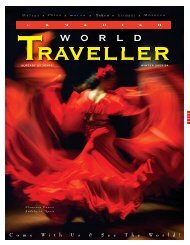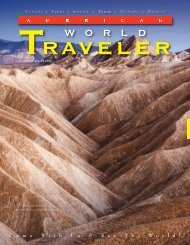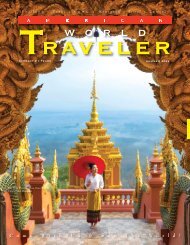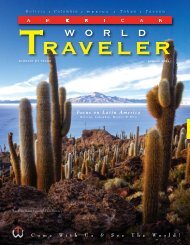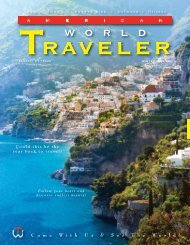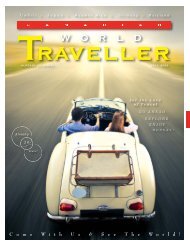Canadian World Traveller / Summer 2016 Issue
www.canadianworldtraveller.com
www.canadianworldtraveller.com
You also want an ePaper? Increase the reach of your titles
YUMPU automatically turns print PDFs into web optimized ePapers that Google loves.
sake producers throughout the country to<br />
show not only the diversity of the brews but<br />
also the creative talents of sake brewers.<br />
Patrons can sample and quaff to their heart’s<br />
content as they seek sakes that best match<br />
their mood and their palate.<br />
Not too far away in the Shimbashi area, a<br />
building full of small eateries and stand-up<br />
sake bars features Shinshu Osake Mura. This<br />
bar specializes in sakes from the Nagano<br />
region but to stay in touch with the latest<br />
trends, it has recently become a magnet for<br />
craft beer aficionados who enjoy the refreshing<br />
complexity of flavours that craft beers<br />
have to offer. In fact while we were in the<br />
bar, several tourists dropped by to purchase<br />
bottles as gifts and souvenirs.<br />
And with taste in mind, we attended a Bento<br />
Making class with True Japan Tour, to learn<br />
about the allure of the ubiquitous ‘bento’ box.<br />
‘Bento’ means ‘convenience’ and usually<br />
refers to a lunch box, divided into sections,<br />
each containing a different food item. They<br />
are sold in food courts, convenience stores,<br />
bus terminals, train stations and airports, with<br />
each type of box featuring different food<br />
combinations.<br />
Under the tutelage of Miss Sayoko Noma and<br />
Miss Naoka Eguchi, our goal was to fill each<br />
of the six sections of our bento box with a different<br />
tasty treat. We started off making a<br />
Japanese omelet in a square frying pan, and<br />
continued with a dish of pumpkin and okra<br />
boiled in dashi broth. This was followed by<br />
chicken tsekouneh: minced chicken, gently<br />
fried and glazed with sugar, soy sauce and<br />
cooking sake. Another dish consisted of<br />
deep-fried marinated chicken strips, and then<br />
a touch of colour was added to the meal with<br />
delicately-arranged green beans (edamame)<br />
and cherry tomatoes. We made Onigiri as an<br />
addition to the Bento meal, consisting of rice<br />
balls wrapped in Nori (seaweed); one with<br />
flaked salmon inside and one with kelp. And<br />
then finally for the last dish, we turned apple<br />
quarters into ‘rabbit-ear apples’ with the<br />
“ears” standing up on the rabbit’s head; a<br />
sure lunch winner for kids (and adults too!)<br />
But in Tokyo, refined tastes come in all shapes<br />
and sizes as we discovered later in the afternoon<br />
when we took our seats in the<br />
Taiwanese Pineapple Cake Shop in the<br />
Omote Sando area to taste the delicate sweet<br />
dessert. We were not in the shop due to<br />
hunger, but because we were on an architectural<br />
discovery tour of the Omote Sando<br />
neighborhood with our City of Tokyo guide<br />
Miss Akiko Enoki.<br />
The building in which the shop is located is<br />
referred to as “Sunny Hills” and was designed<br />
by Kenzo Kuma, one of Japan’s most celebrated<br />
architects. Sunny Hills stands out with<br />
its striking wooden construction amidst a fairly<br />
ordinary-looking residential neighbourhood.<br />
Kuma’s trademark is the melding of<br />
nature with modern construction, and the<br />
nearby Nezu Museum, with its wall of bamboo<br />
trees is one example, while the new<br />
Stadium that Kuma is designing for Tokyo’s<br />
2020 Olympics and referred to as the “habitable<br />
forest” is another attempt to use architecture<br />
to showcase the harmony between<br />
man and nature.<br />
A few streets over we saw another Olympic<br />
connection in the Prada Building, designed by<br />
Herzog and de Meuron who also designed<br />
Beijing’s Bird Nest Stadium for the 2008<br />
games. Our guide pointed out other important<br />
buildings in the area that showcased the<br />
work of architectural luminaries such as Jun<br />
Mitsui, Tadao Ando and Tyo Ito (the latter<br />
designed Tod’s Building on the main strip, to<br />
mimic the zelkova trees that line the streets of<br />
the Omote Sando district). And other architectural<br />
wonders are spread throughout the<br />
city including the Cocoon Building and<br />
Metropolitan Building in Shinjuku, the Audi<br />
Forum, known as the Blue Iceberg in Shibuya<br />
and the iconic Tokyo Sky Tree in Sumida.<br />
In fact, Tokyo’s neighbourhoods are a source<br />
of adventure and discovery on their own.<br />
One can get off at just about any subway station<br />
and, armed with curiosity and a camera,<br />
discover picturesque streets, small specialty<br />
shops, unique Izakayas and bars, and the<br />
neighbourhood ambiance. We found this to<br />
be true on the narrow streets of Shimo<br />
Kitazawa, in the old shops along the main<br />
street of Ningyocho, and in Monzen Nakacho<br />
where we had dinner at Uosan, an inexpensive,<br />
extremely popular (line-ups begin at<br />
4:00 pm) seafood restaurant. In Kappabashi,<br />
where you can purchase just about anything<br />
that relates to kitchens and culinary preparation,<br />
you can also find Wasuke, a small<br />
Izakaya with a friendly atmosphere and excellent<br />
food.<br />
Getting actively involved in a destination<br />
inevitably involves the arts, and Tokyo has a<br />
wealth of excellent theatres and museums,<br />
from the Kabuki Theatre in Ginza to the Edo-<br />
Tokyo Museum in Ryogoku and on to traditional<br />
and contemporary art galleries spread<br />
throughout the city. One of the more interesting<br />
was a visit to the Mori Art Museum in<br />
Rappongi Hills where the featured exhibit was<br />
Takashi Murakami’s masterpiece, the 500<br />
Arhats.<br />
In Buddhism the word ‘arhat’ refers to a person<br />
who is far advanced on the path to<br />
Enlightenment. After the 2011 tsunami and<br />
earthquake that devastated the Tohoku<br />
region, Murakami wanted to do something to<br />
help people recover from the despair. His<br />
response was a 100 metre long painting,<br />
divided into four panels, that portrayed the<br />
500 Arhats and emphasized 500 ways of<br />
healing human suffering, as was done in the<br />
old days, through stories, legends, mythology,<br />
spiritual beliefs and even humour.<br />
The successful blending of the old and the<br />
new in art, architecture, cuisine, museums<br />
and neighbourhoods is the hallmark of a<br />
dynamic city. Keeping pace with the everevolving<br />
city of Tokyo is a pleasurable challenge<br />
and a boon for travellers who are<br />
searching for new, exciting and meaningful<br />
discoveries and experiences.<br />
www.gotokyo.org<br />
15<br />
<strong>Canadian</strong> <strong>World</strong> <strong>Traveller</strong> <strong>Summer</strong>/Fall <strong>2016</strong>







